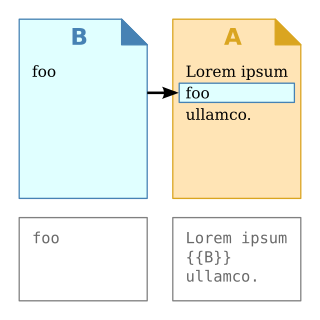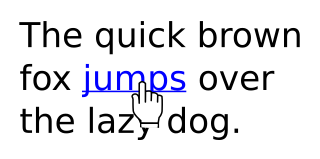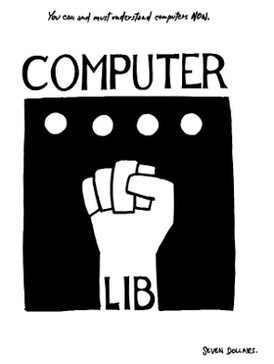Related Research Articles

Hypertext is text displayed on a computer display or other electronic devices with references (hyperlinks) to other text that the reader can immediately access. Hypertext documents are interconnected by hyperlinks, which are typically activated by a mouse click, keypress set, or screen touch. Apart from text, the term "hypertext" is also sometimes used to describe tables, images, and other presentational content formats with integrated hyperlinks. Hypertext is one of the key underlying concepts of the World Wide Web, where Web pages are often written in the Hypertext Markup Language (HTML). As implemented on the Web, hypertext enables the easy-to-use publication of information over the Internet.

In computer science, transclusion is the inclusion of part or all of an electronic document into one or more other documents by reference via hypertext. Transclusion is usually performed when the referencing document is displayed, and is normally automatic and transparent to the end user. The result of transclusion is a single integrated document made of parts assembled dynamically from separate sources, possibly stored on different computers in disparate places.

Memex is a hypothetical electromechanical device for interacting with microform documents and described in Vannevar Bush's 1945 article "As We May Think". Bush envisioned the memex as a device in which individuals would compress and store all of their books, records, and communications, "mechanized so that it may be consulted with exceeding speed and flexibility". The individual was supposed to use the memex as an automatic personal filing system, making the memex "an enlarged intimate supplement to his memory". The name memex is a portmanteau of memory and expansion.

Theodor Holm Nelson is an American pioneer of information technology, philosopher, and sociologist. He coined the terms hypertext and hypermedia in 1963 and published them in 1965. According to a 1997 Forbes profile, Nelson "sees himself as a literary romantic, like a Cyrano de Bergerac, or 'the Orson Welles of software'."

In computing, a hyperlink, or simply a link, is a digital reference to data that the user can follow or be guided to by clicking or tapping. A hyperlink points to a whole document or to a specific element within a document. Hypertext is text with hyperlinks. The text that is linked from is known as anchor text. A software system that is used for viewing and creating hypertext is a hypertext system, and to create a hyperlink is to hyperlink. A user following hyperlinks is said to navigate or browse the hypertext.
Project Xanadu was the first hypertext project, founded in 1960 by Ted Nelson. Administrators of Project Xanadu have declared it superior to the World Wide Web, with the mission statement: "Today's popular software simulates paper. The World Wide Web trivialises our original hypertext model with one-way ever-breaking links and no management of version or contents."
Webster's Dictionary is any of the English language dictionaries edited in the early 19th century by Noah Webster (1758–1843), an American lexicographer, as well as numerous related or unrelated dictionaries that have adopted the Webster's name in his honor. "Webster's" has since become a genericized trademark in the United States for English dictionaries, and is widely used in dictionary titles.
This article presents a timeline of hypertext technology, including "hypermedia" and related human–computer interaction projects and developments from 1945 on. The term hypertext is credited to the author and philosopher Ted Nelson.
Digital poetry is a form of electronic literature, displaying a wide range of approaches to poetry, with a prominent and crucial use of computers. Digital poetry can be available in form of CD-ROM, DVD, as installations in art galleries, in certain cases also recorded as digital video or films, as digital holograms, on the World Wide Web or Internet, and as mobile phone apps.
Electronic literature or digital literature is a genre of literature where digital capabilities such as interactivity, multimodality or algorithmic text generation are used aesthetically. Works of electronic literature are usually intended to be read on digital devices, such as computers, tablets, and mobile phones. They cannot be easily printed, or cannot be printed at all, because elements crucial to the work cannot be carried over onto a printed version.

ZigZag is a data model, invented by Ted Nelson, that deconstructs the spreadsheet to allow irregular relations, at the same time generalizing the idea to multiple dimensions.

Glas is a 1974 book by the French philosopher Jacques Derrida. It combines a reading of Georg Wilhelm Friedrich Hegel's philosophical works and of Jean Genet's autobiographical writing. "One of Derrida's more inscrutable books," its form and content invite a reflection on the nature of literary genre and of writing.

Computer Lib/Dream Machines is a 1974 book by Ted Nelson, printed as a two-front-cover paperback to indicate its "intertwingled" nature. Originally self-published by Nelson, it was republished with a foreword by Stewart Brand in 1987 by Microsoft Press.
Roger Everett Gregory is a US computer programmer, technologist, and scientist. Gregory's work in project Xanadu made him one of the earliest pioneers of hypertext technology, which helped lay the foundations for the hyperlink technology that underlies the World Wide Web. Gregory attended the University of Michigan as a mathematics major. In the 1970s, he founded the Ann Arbor Computer Club, similar to the West Coast's Home Brew Computer Club.
Hyperland is a 50-minute-long documentary film about hypertext and surrounding technologies. It was written by Douglas Adams and produced and directed by Max Whitby for BBC Two in 1990. It stars Douglas Adams as a computer user and Tom Baker, with whom Adams had already worked on Doctor Who, as a personification of a software agent.
Enfilades are a class of tree data structures invented by computer scientist Ted Nelson and used in Project Xanadu "Green" designs of the 1970s and 1980s. Enfilades allow quick editing, versioning, retrieval and inter-comparison operations in a large, cross-linked hypertext database. The Xanadu "Gold" design starting in the 1990s used a related data structure called the Ent.

StretchText is a hypertext feature that has not gained mass adoption in systems like the World Wide Web, but gives more control to the reader in determining what level of detail to read at. Authors write content to several levels of detail in a work.

Glut: Mastering Information Through The Ages is a 2007 book written by Alex Wright, a writer and information architect for The New York Times. Wright's intention is to provide a broad historical overview of the development of information transmission and organization systems.

Hypertext is text displayed on a computer or other electronic device with references (hyperlinks) to other text that the reader can immediately access, usually by a mouse click or keypress sequence. Early conceptions of hypertext defined it as text that could be connected by a linking system to a range of other documents that were stored outside that text. In 1934 Belgian bibliographer, Paul Otlet, developed a blueprint for links that telescoped out from hypertext electrically to allow readers to access documents, books, photographs, and so on, stored anywhere in the world.

The following outline is provided as an overview of and topical guide to books:
References
- ↑ "Xanadu Basics 1b - Indirect Document Delivery". Archived from the original on 2021-12-12.
- Literary Machines: The report on, and of, Project Xanadu concerning word processing, electronic publishing, hypertext, thinkertoys, tomorrow's intellectual revolution, and certain other topics including knowledge, education and freedom (1981), Mindful Press, Sausalito, California.
- Publication dates as listed in the 93.1 (1993) edition: 1980, 1981, 1982, 1983, 1984, 1987, 1990, 1991, 1992, 1993.